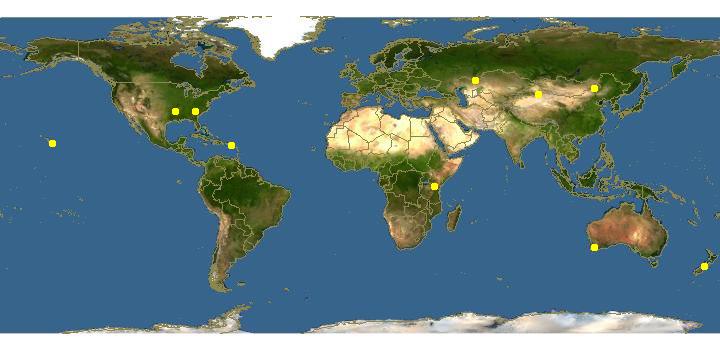
Click on map for details about points.
|
|
Overview | |
Grows and sporulates well on oak bark agar (at pH 8) in company with its food source, an unidentified bacterium (Malaya) and a moniliaceous fungus (Goetricum sp.) isolated with the protostelid. The fungus is generally necessary for sporulation of P. bisporum. May also sporulate in the vicinity of Penicillium sp. Sporocarps 90-220 tall; sporangia globose, 10-13.8 Ám in diam., 1-2-spored; spores 5-7 x 10-13.8 Ám, Spores non-deciduous. Single spores are globose and give rise to 8 flagellate cells on germination, spores in pairs are hemispherical and produce 4 flagellate cells on germination; Flagellate cells typically have a single anterior flagellum, occasionally two of equal length are present. Only rarely is a short flagellum found paired with the longer one. Pseudoflagella (ephemeral filose extensions of the flagellate cell) are also commonly seen. Plurinucleate protoplasts may be found in cultures several days after spore germination. These do not develop flagella or become reticulate. Protoplasmodia divide by plasmotomy, which tends to limit their size and nuclear number. Under conditions not fully understood, plurinuceate protoplasts become converted into worm-like shapes. The vermiform phase has an almost segmented appearance and even undulates in worm-like fashion. The position and shape of the swellings change constantly. At one or both ends of the protoplast there are knob-like areas with short filose pseudopodia. Cysts round to oval or somewhat irregular, 16.3-33.8 x 22.5-53.8 Ám.
|
|
|
Links to other sites | |
|
|
|
Acknowledgements | |
The Eumycetozoan Project -- working to understand the ecology, sytematics and evolution of myxomycetes, dictostelids and protostelids -- the true slime molds.
Sponsored by grants from the National Science Foundation.
|
|
|
Feedback |
Please send any corrections and comments about this page to John Shadwick
Department of Biological Sciences, University of Arkansas, Fayetteville, AR 72701, USA
email: jshadwi@uark.edu
phone: USA-479-575-7393.
|
|
| Supported by | |
Updated: 2024-04-25 03:50:34 gmt
|